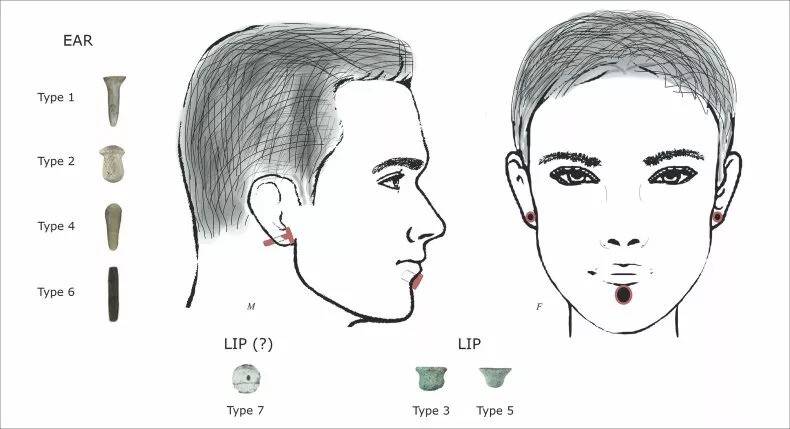The ornaments found at Boncuklu Tarla in Turkey were discovered alongside skeletons, marking the first time that such items were discovered “in situ” with human remains.
Emma Baysal / AntiquityArchaeologists found more than 100 object like this one that were probably used as trunk piercings .
In our meter , seeing someone with facial piercings might elicit a response about “ kids today . ” But the history of facial piercings is an ancient one . And archaeologists in Turkey just come upon the most compelling evidence yet of how ancient the great unwashed used these organic structure decoration .
At the early Neolithic site of Boncuklu Tarla in Turkey , archaeologists find more than 100 ornaments alongside 11,000 - year - old human remains . Though earring - like objects have been discovered before , these decoration provide the “ earliest contextual evidence ” of facial piercings in southwesterly Asia .

Emma Baysal/AntiquityArchaeologists found more than 100 objects like this one that were likely used as body piercings.
The Body Ornaments Of Boncuklu Tarla
As reported in a new work inAntiquity , archaeologists discovered over 100 eubstance ornaments at the Neolithic site of Boncuklu Tarla in Turkey . importantly , the ornaments were discovered alongside the ears and chins of the 11,000 - year - one-time human remains , hinting at their original position .
Though earring have been regain at Neolithic website before , these ornaments are especially intriguing because they were found “ in situ ” within the human burials . What ’s more , some of the skeletons had evidence of wear on their lower incisor , indicative of lower lip piercings known as labrets .
AntiquitySome of the body piercings found at the Boncuklu Tarla site .

AntiquitySome of the body piercings found at the Boncuklu Tarla site.
“ We have find the earliest examples of these ornaments still in plaza on the skeletons of the people who used them , thereby proving exactly how these ornaments were used at this early date for the first clock time , ” Emma Baysal , one of the study ’s co - author and an archeologist with Ankara University in Turkey , explained toNewsweek .
She continued : “ We think these are the earliest examples yet record in their original context on the skeletons of the multitude who used them . We have earlier indirect grounds of labret utilization from other web site — but this is through wear on tooth and not instantly from ornaments on skeletons . ”
How Neolithic People Used Body Ornaments
The 100 ornaments , made of limestone , obsidian , Flint River , Cu , and river pebble , come in all different shapes and size . archaeologist divided them into seven categories base on shape , which range from long - shafted decoration probably tire in the capitulum ( Type 1 ) to ornaments with shorter “ bellying ” shafts ( Type 3 and 5 ) which were used as labrets .
Intriguingly , the body ornaments were chance among the corpse of piece and women at Boncuklu Tarla , but not among the cadaver of children . Children were sometimes lay to rest with pendants or beads , but archaeologist did not discover grounds of ornamentation near their mind like in other graves .
Emma Baysal / AntiquityThe different kinds of body piercings and how they might have been worn by Neolithic people .

Emma Baysal/AntiquityThe different kinds of body piercings and how they might have been worn by Neolithic people.
This perhaps suggests that the torso ornaments at Boncuklu Tarla do more than an aesthetic intent . Rather than make a fashion statement , they may have signified some sort of Neolithic coming - of - years ritual .
“ It ’s probably something associated with being grown - up , ” Baysal remark toCNN . “ mayhap a form of social status link up with age , or a particular role in society . ”
But though there ’s still much to study about how Neolithic hoi polloi used body decoration , what ’s striking to archaeologists is how much facial piercings 11,000 years ago seem to resemble facial piercings now .
“ thing we do today — i.e. use body piercings — can be traced back to some of our prehistorical ancestors many thousands of years ago at a time when they were just start to settle down in the first villages , ” Baysal noted toNewsweek .
To CNN she added : “ When you put earrings on , you ca n’t see the earring that you ’re wearing . You ’re not doing it for yourself , because you ca n’t see them . You ’re doing it for how you project yourself to other mass . And I do n’t think that has changed for all these M of year . It ’s a way that we can identify with people in the past and reckon , ‘ Well , really , they ’re quite like us . ' ”
After read about the 11,000 - class - erstwhile consistence ornament discovered in Turkey , go inside the farsighted andfascinating story of piercings . Or , attend through some of the mostextreme female body modificationsthat exist around the world .